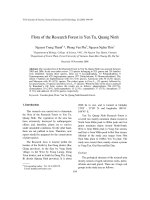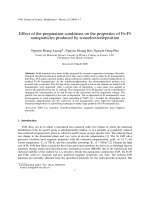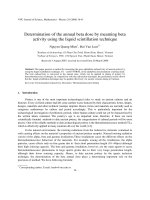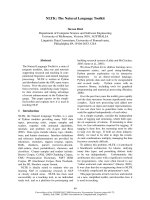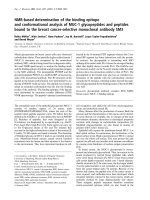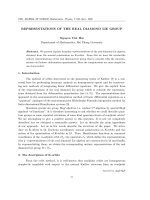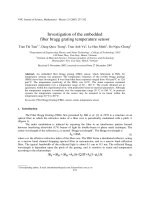Báo cáo " Determination of the 15 MeV bremsstrahlung spectrum from thin W target on the microtron MT-17 accelerator " doc
Bạn đang xem bản rút gọn của tài liệu. Xem và tải ngay bản đầy đủ của tài liệu tại đây (192.27 KB, 7 trang )
VNU Journal of Science, Mathematics - Physics 24 (2008) 81-87
81
Determination of the 15 MeV bremsstrahlung spectrum from
thin W target on the microtron MT-17 accelerator
Pham Duc Khue
1
, Bui Van Loat
2,
*
*
1
Institute of Physics and Electronics, Vietnam Academy of Science and Technology,
18 Hoang Quoc Viet, Hanoi, Vietnam
2
College of Sciences, VNU, 334 Nguyen Trai, Thanh Xuan, Hanoi, Vietnam
Received 23 March 2008; received in revised form 28 March 2008
Abstract. Bremsstrahlung energy spectrum from thin W target produced by 15 MeV incident
electrons was determined by a combination of measurements and theoretical calculation. The
shape of spectrum was calculated by Monte-Carlo method using the code EGS4. The photon flux
measurements were performed based on the activation technique using the high pure metallic foils.
The radioactivities of the irradiated foils were measured by using a gamma spectrometer with a
high energy resolution HPGe detector. The experiments were carried out at the 15 MeV electron
Microtron MT-17 accelerator located at Institute of Physics and Electronics, Hanoi.
1. Introduction
Electron accelerators with moderate energy are being used throughout the world for various
scientific and technological fields [1-3]. The radiations used at electron accelerators are not only the
primary electron beam, but also the secondary beams such as bremsstrahlung photons and neutrons.
Bremsstrahlung photons are produced from direct interaction of fast electrons with the nuclei of the
target. Neutrons are generated mainly from photonuclear reactions induced by the bremsstrahlung
photons. A high intensity gamma source is a good tool for investigating photonuclear reactions,
radiation affects mechanisms and photo activation analysis [1-3].
In order to analyze most experiments when bremmstrahlung radiation used, it is necessary to
know the absolute magnitude of the bremsstrahlung spectrum as a function of the photon energy and
of the emission angle. Many methods are available for the investigation of bremsstrahlung spectra.
The theoretical prediction of bremsstrahlung spectra has been carried out using different method [4].
Among them the simulation of electromagnetic cascades by means of the Monte-Carlo method has
been slowly gaining acceptance.
Despite the relatively advanced state of the theoretical calculation, a lot of accurate, absolute
measurements have been made of the spectrum of bremsstrahlung photons [5,6]. There are many
methods of measuring the bremsstrahlung such as direct method using detectors or through the use of
compton magnetic spectrometers, and indirect methods such as the use of photoneutron time of flight
or activation of special materials. The advantages and limitations of each method have been discussed
______
*
Corresponding author. E-mail:
P.D. Khue, B.V. Loat / VNU Journal of Science, Mathematics - Physics 24 (2008) 81-87
82
elsewhere.
The purpose of the present work was to investigate the energy spectrum of bremsstrahlung
photons emitted from the thin W target bombarded by 15 MeV electron beam from the Microtron MT-
17 accelerator at the Institute of Physics and Electronics.
In this study, the activation foil technique and gamma spectrum measurement was used to
determine the photon flux. The main advantages of this method are high sensitivity, accuracy and the
experimental procedure is rather simple and feasible. By this way, the photon intensity can be
determined based on the activity of the activated different foils. From the absolute photon fluxes, we
have constructed the bremsstrahlung energy spectrum based on the unfolding technique in
combination with the spectrum shape which was calculated using the code EGS4. The EGS4 system
(Electron Shower Gamma 4) is standard for Monte-Carlo calculations of radiation transport [4,7].
2. Experimental
The Microtron MT-17 accelerator can accelerate electron beam up to energy of 15 MeV and
produce intense bremsstrahlung and photoneutrons. The accelerated electron beam hits the W-target to
produce the bremsstrahlung. The dimension of the W-target is 40 mm in diameter and thickness of 1
mm. The induced bremsstrahlung spectrum covers the energy range from zero to 15 MeV.
During our experiments, the Microtron MT-17 accelerator was operated with an electron
energy of 15 MeV and 10 µA beam current. The irradiation time was 137 min yielding enough the
activities to be measured in a gamma-ray counting system.
In this study, we used Au and In foils as the threshold detectors for the photon flux
measurements. All foils employed were disk-shaped with diameter of 20 mm and with thickness of 0.1
mm. For irradiation, the foils was positioned 4 cm far from the W target and at 90 degree with respect
to the 15 MeV electron beam direction. The simplified experimental arrangement is shown in Fig.1.
The main characteristics of the nuclear reactions investigated and decay data of the reaction products
are presented in Table 1[9].
Fig. 1. Experiment arrangement for the investigation of Bremsstrahlung from the W target.
P.D. Khue, B.V. Loat / VNU Journal of Science, Mathematics - Physics 24 (2008) 81-87
83
Table 1. Nuclear reactions used for bremsstrahlung spectrum measurements
Main gamma – rays Nuclear reaction Threshold
energy,
E
th
(MeV)
Half-life,
T
1/2
Energy (keV) Intensity, %
Isotopic
abundance %
197
Au(γ,n)
196
Au
8.07 6.183 d 333.03
355.68
1091.4
22.9
86.9
0.15
100
115
In(γ,n)
114m
In
9.23 49.51 d 190.27
588.43
725.24
15.4
4.39
4.39
95.7
In practice, the metal foils are activated by photons and radioisotopes formed after the
irradiations were identified from the pulse-height spectrum by their gamma photopeak energies and
half-lives. Their activities were determined from gamma photopeak area and detection efficiencies at
the photopeak energy. The average activity of the activation foils served as photon flux to which the
foils were exposed. The relation between the average photon flux, φ, and the number of detected
gamma rays, C, can be expressed as follows:
[1 exp( )] exp( )[1 exp( )]
o i d c
C
N I F t t t
γ
λ
φ
σ ε λ λ λ
=
− − − − −
(1)
where: N
o
is the number of target nuclei; ε is the photopeak efficiency of the detector; I
γ
is the
branching ratio or intensity of the gamma ray ; λ is the decay constant; F is correction factor; t
i
is the
irradiation time; t
d
is the decay time or the time between end of irradiation and start of counting; t
c
is
the measuring time.
100 1000
0.01
0.1
1
10
100
1000
100000
10000
1000
100
10
1
Relative efficiency(%)
133
Ba
137
Cs
152
Eu
241
Am
60
Co
Absolute efficiency(%)
Energy(keV)
Fig. 2. Photopeak efficiency curves of the gamma spectrometer with HPGe detector relative efficiency
curve, absolute efficiency curve.
P.D. Khue, B.V. Loat / VNU Journal of Science, Mathematics - Physics 24 (2008) 81-87
84
In activation method, the actual results of the measurements are the counting rates of the
irradiated foils. After irradiations and appropriate cooling time, the foils were taken off and the
induced gamma activities were measured by gamma spectrometer. It consists of a high purity coaxial
germanium HPGe detector (CANBERRA), which is coupled to a computer based multichannel
analyzer system. The energy resolution of the system is 1.8 keV at 1.332 of
60
Co standard source. The
gamma spectra were measured and analyzed by the program S100 (Canberra).
The photopeak efficiency curve of the gamma spectrometer was calibrated with a set of
standard sources such as
241
Am,
137
Cs,
60
Co,
152
Eu,
133
Ba and
226
Ra. The main steps of the procedure are
(1) to determine the relative efficiency curve based on multi-energy gamma sources and then (2) to
transform the measured relative efficiency curve to absolute one based on single energy gamma
sources. The detection efficiencies were fitted by using the following function:
5
0
ln ln
n
n
n
a E
ε
=
=
∑
, (2)
where
ε
is the detection efficiency, a
n
represents the fitting parameters, and E is the energy of the
photopeak. The relative and absolute efficiency curves were presented in Fig.2. [5].
3. Results and discussion
In this investigation, the threshold photonuclear reactions
197
Au(γ,n)
196
Au and
115
In(γ,n)
114m
In
were used for the photon flux measurements. The induced gamma activities were measured by gamma
spectrometer with HPGe detector. Each sample was measured several times in order to follow the
decay of the different isotopes. Some typical gamma spectra of the activated foils under investigation
are shown in Fig.3 and Fig.4, respectively. After making necessary corrections for the usual
experimental errors such as dead time, pile-up, gamma ray branching ratio, self-absorption of gamma
rays and detector efficiency, the photon fluxes can be derived from the measured activities based on
equation (1). The activation cross sections used in our calculations were taken from reference [9].
From the photon fluxes determined based on different threshold reaction energies, we
calculated the photon fluxes per kW beam power, φ (ph.s
-1
.
sr
-1
.kW
-1
), and presented in Table 2.
Table 2. Integral photon fluxes determined based on different threshold reaction energies.
Nuclear reaction E
th
(MeV)
φ (ph.s
-1
.sr
-1
.kW
-1
)
197
Au(γ,n)
196
Au
8.07
(1.06±0.09)×10
11
115
In(γ,n)
114m
In
9.23
(7.44±0.67)×10
10
Following, the differential photon flux in the energy bin ∆E = E
th
(In) - E
th
(Au) can be derived
from the values of integral photon flux as follows:
∆φ= φ(Au) - φ(In) (3)
From the differential photon flux we can constructed an absolute bremsstrahlung energy
spectrum by a combination with the relative spectrum calculated by using the code EGS4. The
obtained bremsstrahlung spectrum is presented in Fig.5.
P.D. Khue, B.V. Loat / VNU Journal of Science, Mathematics - Physics 24 (2008) 81-87
85
Fig. 5 show that the energy spectrum of bremsstrahlung is continuous the upper and that equals
the kinetic energy of the bombarding electron. The slowing down of electrons due to ionization losses
leads to reduction of the high energy part in relation to low-energy radiation. The shape of the
obtained bremsstrahlung spectrum is similar to that reported by some other authors [8,9].
Fig. 3. Gamma-ray spectrum of Gold foil irradiated by 15 MeV Bremsstrahlung with irradiation time 137 min,
the waiting time 8817 min, and the measuring time 30 min.
Fig. 4. Gamma-ray spectrum of Indium foil irradiated with 15 MeV Bremsstrahlung with irradiation time 137
min, the waiting time 3080 min, and the measuring time 30 min.
P.D. Khue, B.V. Loat / VNU Journal of Science, Mathematics - Physics 24 (2008) 81-87
86
0 2 4 6 8 10 12 14 16
10
8
10
9
10
10
10
11
10
12
10
13
10
14
Calculation (EGS4)
Experiment
Bremsstrahlung intensity (ph.s
-1
.sr
-1
.kW
-1
)
Photon energy (MeV)
Fig. 5. Bremsstrahlung spectrum from W-target bombarded by 15 MeV electrons from MT-17 accelerator.
The main sources of the uncertainties for the present results were estimated due to statistical
errors: (0.5÷ 1%), the geometrical factor for irradiation and measurement of the activation foils:
(0.8÷1.5%), the detection efficiency: (2÷3%), nuclear decay data used such as half-life and gamma
branching ratio: (2÷4%).
In this study, in order to limit the experimental errors, the (γ,n) photonuclear reactions for Au
and In were used as activation detectors, because of their high reaction cross-section in the energy
range of interest. Furthermore, the interferences caused by competing reactions were avoided.
In conclusion, we can say that the obtained energy spectrum of bremsstralung photons are
useful not only for nuclear data measurements, but also help in understanding the nuclear interaction
processes involved in the production of bremsstrahlung. For practical applications, the obtained data
are useful in making detailed shielding calculations and photo activation analysis.
Acknowledgements. The authors are grateful to Prof. Nguyen Van Do for his continuous interest in
this work. We also would like to thank the colleagues in the Center of Nuclear Physics, Institute of
Physics and Electronics for their help during the experiment. This work is financially supported by
QG-07-06 project.
References
[1] Y. M.Tsipennyuk, The Microtron development and application, Taylor & Francis, 2002.
[2] V.L. Auslender et al., Bremsstrahlung converters for powerful industrial electron accelerators, Radiat. Phys. Chem. 71
(2004) 295.
[3] P.Lahorte et al., Applied radiation research around a 15 MeV high average power linac. Radiat. Phys. Chem. 55
(1999) 761.
P.D. Khue, B.V. Loat / VNU Journal of Science, Mathematics - Physics 24 (2008) 81-87
87
[4] K.Van Laere, W. Mondelaers, Full Montercarlo simulation and optimization of a high power bremsstrahlung
converter, Radiat. Phys. Chem. 49 (1997) 207.
[5] Nguyen Van Do, Pham Duc Khue, Angular characterization of 15 MeV and 65 MeV bremsstrahlung photons from W-
target, Communications in Physics Vol. 15 No.1 (2005) 1.
[6] D.J.S. Findlay, Analytic representation of bremsstrahung spectra from thick radiators as function of photon energy and
angle, Nucl. Instr. and Meth. A276 (1989) 589.
[7] Richard B. Fiestone, Table of Isotopes, Wiley–Interscience, 1996.
[8] A. Calzado, E. Vano, V. Degado, L. Gonzalez, 42 MeV bremsstrahlung spectrum analysis by photoactivivation
method, Nucl. Instr.and. Meth. 225 (1984) 232.
[9]
